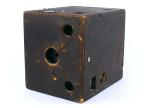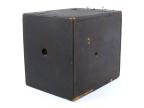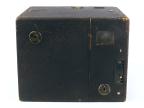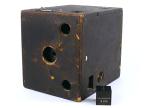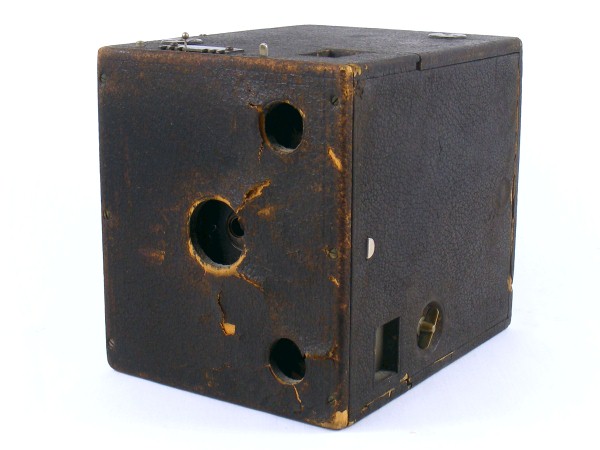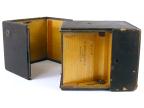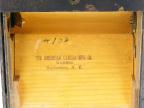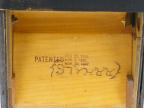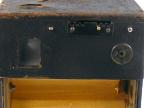Buckeye Camera
The American Camera Mfg Co
| Name: | Buckeye No 2 |
| Manufacturer: | The American Camera Mfg Co |
| Country of Origin: | USA |
| Construction: | Paper covered wooden box camera for rollfilm. |
| Production Period: | 1895 - 1904? |
| Plate / Film Size: | 4 x 5 rollfilm |
| Lens: | Achromatic (TBC) |
| Shutter: | Dual speed shutter (Time & Instantaneous) |
| Movements: | None |
| Dimensions (w x h x l): | |
| Date of this Example: | c1899 |
| Serial Number: | No evidence of any serial number. |
| Availability: |
|
| Inventory Number: | 617 |
|
Photos copyright © 2014 David Purcell. Do not use without permission. |
Description
The Buckeye camera is a large box camera for rollfilm only. It is marked inside with the makers name, with their location shown as Rochester NY. The American Camera Mfg Co was started by Thomas Blair in 1895 but was sold to George Eastman in 1897. At that stage the company was based in Northboro Massachusetts, but was moved to Rochester in 1899.
This example of the Buckeye camera carries three patent dates, the last of which is dated 30 Nov 1897. It seems likely therefore that this example dates to the period after the move.
Unfortunately the name of the camera is not shown anywhere on the camera body and there is no evidence that it ever carried any form of badge. It may be that the name was embossed in the camera handle, which is missing from this example. However simple cameras produced by the company in this period were part of a range of box and folding cameras marketed under the "Buckeye" name.
Advertisements for the Buckeye identify two sizes: one for images 3½" x 3½" (No 1 Buckeye) and a larger model for 4" x 5" (No 2 Buckeye). This camera is certainly for the larger size, although the camera has a hand written inscription for "#103" by the film chamber. The image size for film number 103 is 3¾" x 4¾", which is also consistent with the dimensions of the rear aperture. However, I assume this camera must have been advertised as 4 x 5.
The inside of the camera is quite attractive, with the film carrier constructed from polished light wood, although the carcase as a whole seems to be constructed from several different woods. Three sides of the camera come away as a single shell in order to access the film chamber, held in place by a hidden catch on one side.
This particular example is showing the effects of age. The thin leather effect paper covering has dried out and split over the years, and small sections have been lost, revealing the wooden body beneath.
Notes
Box and folding cameras bearing the Buckeye name appear with the name of American Camera Manufacturing Company identified as the maker, as in this example, but similar cameras were also advertised by E. & H.T. Anthony & Co. It seems very likely that early Buckeye cameras were made by The American Camera Manufacturing Company and simply marketed by Anthony. Prior to Thomas Blair selling his interests to Eastman Kodak, E. & H.T. Anthony & Co were trade agents for his companies [13]. However the Buckeye name was still used for cameras sold by Anthony after The American Camera Manufacturing Company was sold off to Kodak, although the drawings of the camera in Anthony adverts that appeared early into 20th century do not match this camera. It is possible that Anthony negotiated to retain use of the Buckeye name and then made cameras themselves after the sale to Kodak, but as yet I have no firm evidence for this.
The relationship between the various companies Blair owned and did business with, including E. & H.T. Anthony & Co and Eastman Kodak, is as interesting as it was fraught with difficulties and complex law suits! An outline of the story leading up to the sale of the Blair Camera Company and The American Camera Manufacturing Company can be found in Elizabeth Brayer's biography of George Eastman [14, p189].
![[ ]](../../images/unchecked.png)
![[x]](../../images/checked.png)
